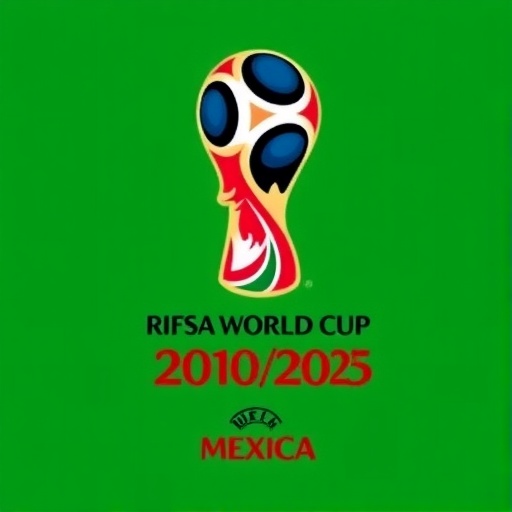United States Partners with Mexico, Costa Rica, and Jamaica in Bold Joint Bid for 2031 FIFA Women’s World Cup
In a groundbreaking move that’s set to redefine women’s soccer on the global stage, the United States has officially joined forces with Mexico, Costa Rica, and Jamaica to launch a joint bid for the 2031 FIFA Women’s World Cup. This ambitious collaboration promises to deliver the largest and most inclusive tournament in history, with over 30 cities across the United States already vying to host matches. Announced today, the bid underscores a unified North American vision to elevate the sport, drawing on shared infrastructure from the recent men’s World Cup and tapping into booming fan enthusiasm for women’s athletics.
- Uniting Four Nations: The Strategic Alliance Shaping the 2031 Bid
- US Cities Rally: Over 30 Venues Poised for World Cup Glory
- FIFA’s Vision Aligns: Why 2031 is the Perfect Stage for Women’s Soccer Evolution
- Overcoming Hurdles: Economic, Logistical, and Cultural Challenges Ahead
- Legacy in the Making: How the 2031 Bid Could Transform Women’s Soccer Globally
The FIFA Women’s World Cup, which captivated millions during its 2023 edition in Australia and New Zealand, saw record-breaking viewership of over two billion globally. Now, this joint bid from the United States, Mexico, Costa Rica, and Jamaica aims to surpass those numbers, leveraging diverse cultural landscapes and advanced venues to create an unforgettable spectacle. FIFA’s decision to expand the tournament to 32 teams starting in 2027 makes this bid even more pivotal, as organizers pledge innovations in sustainability, accessibility, and community engagement.
Uniting Four Nations: The Strategic Alliance Shaping the 2031 Bid
The seeds of this joint bid were planted amid the success of the 2026 FIFA Men’s World Cup, co-hosted by the United States, Mexico, and Canada. Building on that momentum, the inclusion of Costa Rica and Jamaica brings fresh energy from Central America and the Caribbean, regions hungry for major soccer events. “This partnership isn’t just about hosting games; it’s about fostering a legacy of empowerment for women in sports across our hemisphere,” said Cindy Parlow Cone, president of U.S. Soccer, in a statement released Wednesday.
Representatives from each nation gathered virtually last month to formalize the bid, with Mexico’s Federación Mexicana de Fútbol (FMF) leading early discussions. Mexico, a soccer powerhouse with a passionate fanbase, will contribute iconic venues like the Estadio Azteca in Mexico City, which hosted the 1970 and 1986 men’s finals. Meanwhile, Costa Rica’s National Stadium in San José and Jamaica’s National Stadium in Kingston offer vibrant atmospheres infused with local rhythms and resilience—Jamaica’s Reggae Girlz famously reached the 2019 World Cup knockout stages against all odds.
The bid’s structure divides responsibilities strategically: The United States will handle the bulk of matches, utilizing its vast network of stadiums, while Mexico focuses on group stages in its southern cities. Costa Rica and Jamaica will host select knockout rounds, emphasizing regional equity. This model addresses FIFA’s push for broader geographic representation, a shift evident since the 2019 tournament in France drew diverse crowds from 157 countries.
Economically, the alliance is projected to generate over $2 billion in revenue, according to preliminary estimates from bid organizers. This includes tourism boosts—think beachside training camps in Jamaica and eco-tours in Costa Rica—alongside job creation in event management and broadcasting. “We’re not just bidding for 2031; we’re investing in a soccer ecosystem that benefits generations,” added Victor Montagliani, CONCACAF president, highlighting the confederation’s unified support.
US Cities Rally: Over 30 Venues Poised for World Cup Glory
Excitement is palpable in the United States, where more than 30 cities have expressed interest in hosting games for the 2031 FIFA Women’s World Cup. From the bustling streets of Los Angeles to the historic fields of Philadelphia, these metropolises are gearing up to showcase American hospitality and soccer fervor. Atlanta, with its Mercedes-Benz Stadium, and Miami, home to Hard Rock Stadium, are frontrunners, both having proven their mettle during Copa América Centenario in 2016.
Other contenders include Seattle’s Lumen Field, known for its rainy but roaring crowds, and Kansas City’s Arrowhead Stadium, which set attendance records for the 2023 NWSL Championship. Even smaller markets like Cincinnati and Nashville are in the mix, reflecting the bid’s commitment to nationwide inclusivity. “Bringing the World Cup to our heartland cities will inspire young girls from all walks of life,” noted U.S. Soccer CEO James Addison, emphasizing grassroots impact.
Infrastructure upgrades are already underway in several spots. For instance, SoFi Stadium in Inglewood, California, is enhancing its fan zones to accommodate families and diverse audiences, drawing lessons from the 2028 LA Olympics planning. The bid envisions a tournament footprint spanning coast to coast, reducing travel emissions through efficient routing— a nod to FIFA’s sustainability goals, which mandate carbon-neutral events by 2030.
Statistics underscore the potential: The 1999 FIFA Women’s World Cup in the United States drew 90,000 fans to the Rose Bowl final, a moment that turbocharged the sport’s growth here. Today’s bid aims to eclipse that, with projections of 1.5 million total attendees across venues. Local economies stand to gain immensely; a Deloitte study on past World Cups estimates $500 million in U.S. spending alone from ticket sales, merchandise, and hospitality.
- Key US Venues in Contention: Los Angeles (SoFi Stadium), New York/New Jersey (MetLife Stadium), Dallas (AT&T Stadium), Chicago (Soldier Field).
- Emerging Hubs: Austin, Denver, and Orlando, blending modern facilities with cultural flair.
- Innovation Focus: All sites will feature women-led legacy programs, like soccer academies for underserved communities.
FIFA’s Vision Aligns: Why 2031 is the Perfect Stage for Women’s Soccer Evolution
FIFA’s strategic roadmap makes the 2031 FIFA Women’s World Cup a landmark edition. With the tournament expanding to 32 teams, the joint bid from the United States, Mexico, Costa Rica, and Jamaica aligns seamlessly with the governing body’s goals of global expansion and gender equity. FIFA President Gianni Infantino praised the initiative, stating, “This bid represents the future of our sport—collaborative, innovative, and dedicated to growing women’s football worldwide.”
Contextually, women’s soccer has exploded in popularity. The 2023 World Cup generated $570 million in revenue, a 40% increase from 2019, per FIFA reports. Yet challenges persist: Pay equity battles, like the U.S. Women’s National Team’s 2022 equal-pay victory, highlight the need for high-profile platforms. This bid positions North America as a leader, building on the 1991 and 1999 U.S.-hosted events that birthed modern women’s professionalism.
In Mexico, where soccer is woven into national identity, the bid taps into Liguilla fever while promoting female participation—only 20% of Mexican youth leagues are co-ed currently. Costa Rica‘s inclusion addresses Central America’s underrepresentation; the country’s La Selección Femenina qualified for the 2015 World Cup, inspiring a new generation. Jamaica, with its sprinting heritage translating to soccer speed, sees this as a chance to professionalize the Reggae Girlz further.
Technological integrations will set 2031 apart: Expect VAR enhancements, AI-driven fan experiences, and virtual reality broadcasts to reach remote audiences. Security protocols, informed by the 2026 men’s event, will ensure safe environments, crucial after incidents like the 2022 Qatar controversies. Bid documents outline a $100 million investment in anti-discrimination initiatives, partnering with organizations like UN Women.
Overcoming Hurdles: Economic, Logistical, and Cultural Challenges Ahead
No bid of this scale comes without obstacles. The joint bid must navigate complex logistics across four countries, including visa harmonization and transportation networks. Costa Rica‘s tropical climate poses weather risks for July-August matches, prompting proposals for climate-controlled training facilities. In Jamaica, infrastructure upgrades at the National Stadium could cost $50 million, funded partly through FIFA grants and private sponsors like Nike and Adidas.
Economically, while the United States boasts robust funding via the USSF’s $100 million+ annual budget, smaller partners like Costa Rica rely on international aid. Critics worry about debt burdens, echoing Brazil’s 2014 World Cup fallout, but organizers counter with phased investments tied to tourism revenue—projected at $800 million regionally.
Culturally, the bid emphasizes sensitivity: Training modules for volunteers on inclusivity will address issues like machismo in Latin American soccer cultures. Quotes from Jamaican forward Khadija Shaw underscore the stakes: “Hosting here would show the world that Caribbean girls can dream big in sports.” Meanwhile, Mexican officials highlight anti-corruption measures, learning from past scandals in CONMEBOL.
Competition looms—bids from Brazil and a European consortium are rumored—but the North American alliance’s experience gives it an edge. FIFA’s bidding process, launching formally in 2024, will involve site visits and fan consultations, with a decision expected by 2027.
Legacy in the Making: How the 2031 Bid Could Transform Women’s Soccer Globally
Looking ahead, a successful 2031 FIFA Women’s World Cup could catalyze seismic shifts. In the United States, it might accelerate NWSL expansion to 16 teams by 2030, building on current attendance highs of 10,000+ per match. Mexico‘s Liga MX Femenil could see doubled enrollment, while Costa Rica and Jamaica invest in national academies, potentially qualifying more teams for future tournaments.
Globally, the event promises to bridge divides, with initiatives like free streaming in developing nations to boost viewership equity. Economists forecast a $5 billion ripple effect on gender-balanced hiring in sports industries. As bid leaders prepare dossiers for FIFA’s review, the message is clear: This isn’t just a tournament; it’s a movement toward parity and passion in women’s soccer.
Stakeholders urge swift action—public support campaigns are launching in all four countries, inviting fan input via online portals. If awarded, preparations ramp up in 2028, aligning with Olympic cycles for maximum visibility. The world watches as this joint bid for 2031 positions North America at the forefront of soccer’s most exciting evolution.










